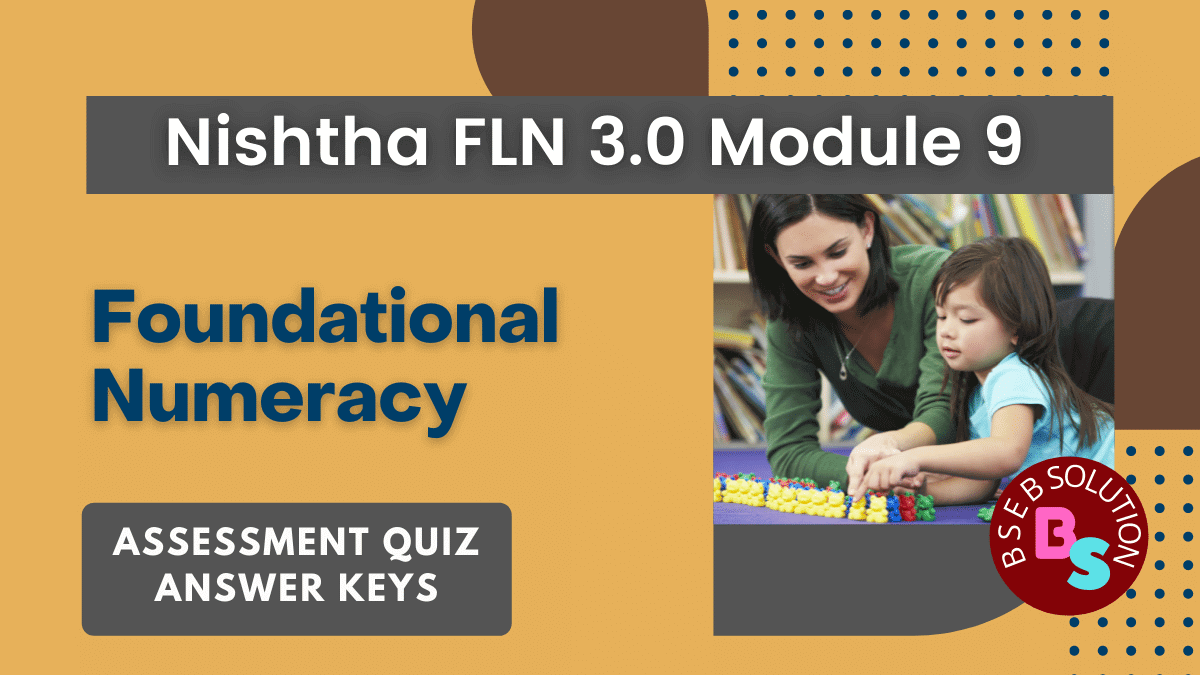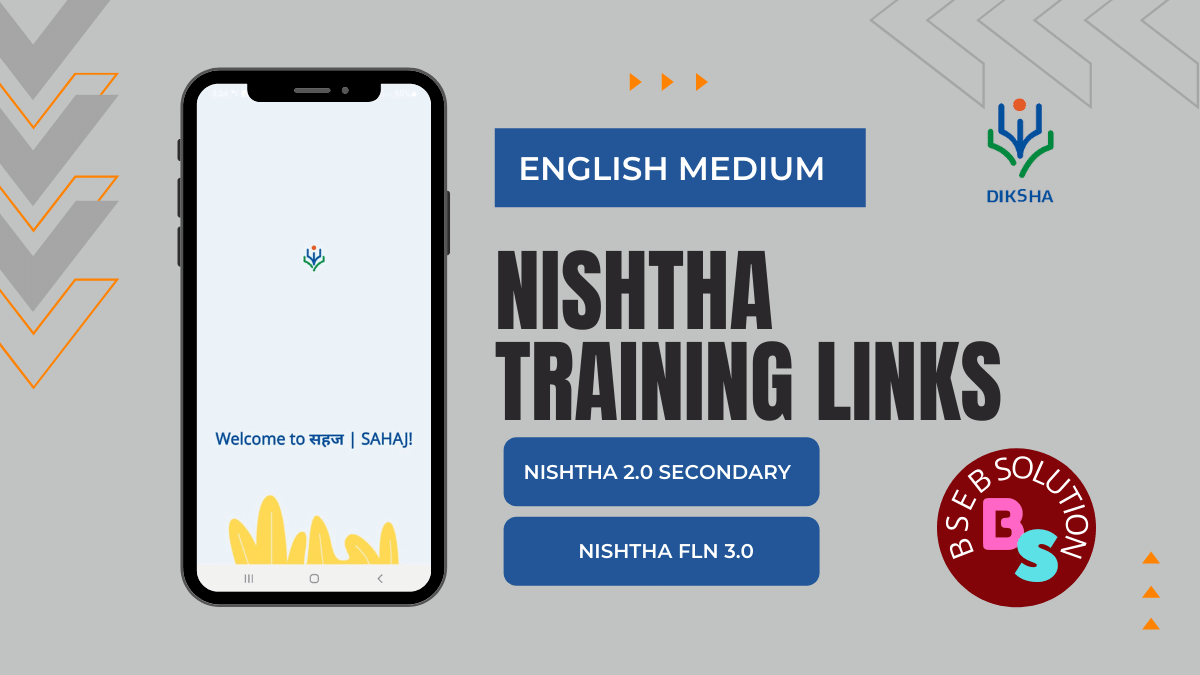This course is designed to help teachers and workers in early childhood education and care centres like anganwadis, standalone nursery schools and nursery schools attached to primary schools in building their understanding of numeracy. Thus, the course contains the content knowledge and pedagogical processes to form a strong foundation of early mathematical and numeracy skills integrated with literacy among all children up to the age of 8-9 years. In this post you will be able to know AR, UP, UK, MZ, NL, OD, PB, AP, AS, BH, GJ, HR, HP, JK, JH, KA, MP, CHD, CG, DL, GA, MH, CBSE, KVS, NVS, MN, ML, RJ, SK, TS, TR, Nishtha FLN 3.0 Module 9 Foundational Numeracy Quiz question and Answer Key PDF in English for Primary School Teachers of all states. यदि आप यह प्रश्नोत्तरी हिन्दी में पढ़ना चाहते हैं, तो यहाँ क्लिक करें |
Nishtha FLN 3.0 Module 9 Answer Key “Foundational Numeracy”
The assessment questionnaire of Nishtha 2.0 and 3.0 training is the same in all states, but the Training Links are different. Out of around 40 questions, you will get only 20 random questions in an attempt. You will be able to get the certificate by scoring 70% marks in maximum three attempts.
All the Nishtha trainings available on Diksha App are design to improve teacher performance. So, take all the training seriously and solve the assessment quiz at the end. Certificate will issued only after securing 70% marks in the evaluation quiz. If you face any kind of problem in solving question of Nishtha FLN 3.0 Module 9 Quiz then get complete solution here.
Nishtha FLN 3.0 Module 9 Answer Key
Q. 1: Which of the following scenarios is not involved in the Word problems related to addition and Subtraction?
- Classification of objects
- Combination of two or more objects
- increase or decrease of same quantity
- Comparison of objects
Q. 2: Which of the following is not a correct way of assessment
- A test based on memorisation
- A subjective test according to the learning levels of children
- Use of self-assessment
- Use of audio-visual tool for assessment
Q. 3: Numbers are used to communicate the size of
a group of objects.
- Ordinal numbers
- Cardinal numbers
- Nominal numbers
- All of the above
Q. 4: Which of the following does not involve the ordering a
collection of objects according to the given rule.
- Seriation
- Arrangement
- Classification
- Patterning
Q. 5: How many times should we add 4 to get 16
- Sixty four times
- Twenty times
- Sixteen times
- Four times
Q. 6: Which of the following is not a type and utility of
numbers;
- Nominal Numbers
- Ordinal Numbers
- Aesthetic Numbers
- Cardinal Numbers
Q. 7: Essential requirement to classify objects is to:
- Read the names of the shapes
- Identify the objects by their characteristics
- Know the name of the objects
- Recite the name of the objects
Q. 8: For building upon the understanding of one-to-one correspondence, children do not need to understand the meaning of
- many and few
- as many as
- numeration
- more than/ less than
Q. 9: Which of the following is not an objective of making a child proficient in numeracy in the foundational years?
- It helps in achieving learning outcomes in later
- stages
- It helps in developing logical thinking and
- reasoning in daily life
- It helps them in dealing with numbers
- It helps them to do fast calculations
Q. 10: Which of the following is not a component of foundational numeracy:
- Data Handling
- Memorizing number names
- Patterns
- Mathematical Communications
Q. 11: The ability to immediately perceive the cardinality of a collection, usually not more than four or five elements without counting is called as
- Classification
- Conservation
- Seriation
- Subitization
Q. 12: What is the right sequence to teach numbers:
- Opportunities for Counting
- Writing numerals
- Reading numerals
- Developing number sense
- 1,2,3,4
- 1,4,3,2
- 1,4,2,3
- 2,1,3,4
Q. 13: What is subitising?
- Ability to recite number names up to ten
- Ability to count
- Ability to discriminate between objects
- Ability to identify the number of objects by simply looking at them and without actually counting each object.
Q. 14: Which of the following is not a component of Data Handling?
- Representation of Data
- Interpretation of Data
- Construction of Data
- Collection of Data
Q. 15: What are numerals?
- Value of numbers
- Size of numbers
- Number names
- Symbols for numbers
Q. 16: ______Number are used to describe the position of an object when they are arranged in a specific order.
- Ordinal Number
- Cardinal Number
- Aesthetic Number
- Nominal Number
Q. 17: When does a child is said not to acquire understanding of shapes and space?
- When he/she crams the names of shapes like cube, cuboid, sphere, etc. without understanding
- When he/she explores and communicates association between an object and its shape
- When he/she observes the objects in the environment and their geometrical attributes
- When he/she uses own vocabulary to describe space and the shapes
Q. 18: Which of the following is the most appropriate strategy
to teach shapes at a foundational stage?
- Shapes at foundational stage should be limited to the recognition of simple basic shapes
- Development of extensive vocabulary of shapes need to be the primary objective at foundational stage
- Children should be given ample opportunities to develop intuitive understanding of shapes
- Teacher should introduce by giving clear definition of simple shapes
Q. 19: Which of the following pairs are not complementary to each other?
- Multiplication and Division
- Addition and Multiplication
- Addition and Subtraction
- Subtraction and Multiplication
Q. 20: In order to ensure strong FLN the children should be assessed-
- through question paper which have more questions from the textbooks
- through weekly and monthly tests
- continuously through formative/adaptive methods
- Annually by state/district authority
Q. 21: Which of the following is the most crucial aspect of learning multiplication?
- Understanding multiplication as finding “how many times”
- Recall of tables and their recitation
- Memorization of multiplication facts
- learning the multiplication algorithm and solving sums
Q. 22: Child should be able to seriate objects before learning numbers, because seriation is:
- not related to counting
- related with ordination or placing numbers in order
- needed for operations on numbers
- about reciting number names
Q. 23: Which of the following is not a dimension of
assessments of mathematics learning?
- Communication
- Procedural knowledge
- Disposition towards mathematics
- Mathematical reasoning
Q. 24: What should be the appropriate sequence in
earning/understanding multiplication?
i. Applying distributive law of multiplication w.r.t. addition
ii. Understanding the meaning of multiplication
iii. Learning the algorithm of multiplication
iv. Understanding and using the language of multiplication
- ii, iv, i, iii
- iv, ii, iii, i
- iv, iii, i, ii
- i. ii, iii, iv
Q. 25: ‘Seema has 12 roses. Shifa has 15 roses. Who has more and by how much?’ What subtraction context has been used in the above word problem?
- What left
- Complementary addition
- Take away
- Comparison
Q. 26: Which is of the following is not true:
- All squares are rectangles
- All squares are parallelograms
- All rectangles are parallelograms
- All rectangles are squares
Q. 27: Which of the following pre- school teachers should avoid?
- Include items in the classroom and at home that promote mathematical thinking
- Ask children to write numbers before number sense
- Building on everyday activities of children
- Use language focused on mathematical concepts
Q. 28: The concept of ‘zero’ can be introduced best through which of the following operations?
- Subtraction
- Division
- Multiplication
- Addition
Q. 29: During the learning of Mathematics at early stages, a child is not expected to-
- Use the vocabulary for understanding of space and shapes
- Learn Counting before number sense
- Learn Conventions needed for Mathematical techniques
- Think mathematically and taking decisions with reasoning
Q. 30: Which of the following is not a pedagogical process to
enhance foundational Numeracy skill:
- Using poems, rhymes, stories, riddles in mathematics
- Use of manipulative
- Instruction in home language
- Giving lots of practise questions
Q. 31: Which of the following does not involve cne to one correspondence?
- Matching
- Mapping
- Grouping
- Pairing
Q. 32: The process by which information is exchanged
between individuals through mathematical symbols, signs, diagrams, graphs is known as
- first language learning
- language acquisition
- mathematical Language
- mathematical communication
Q. 33: Which of the following is not a mathematical process?
- Visualization
- Estimation
- Spatial understanding
- Rote Memorization
Q. 34: Which of the following is not a key skill to develop under Number sense
- Recitation of number names
- Applications of basic operations in daily life
- Comparison of numbers like bigger than/smaller than
- Fundamental operations like addition/subtraction
Q. 35: Which of the following is not a pre number skill:
- knowing numerals
- seriation
- classification
- one to one correspondence
Q. 36: Activities on matching or pairing of objects will help in che development of which pre-number skill
- Classification
- Counting on
- Seriation
- One to one correspondence
Q. 37: Putting together things that have some characteristics in common enhances the competence of
- mathematical communication
- number sense
- classification
- seriation
Q. 38: Which of the following should not be an approach for teaching measurement?
- Directly introducing standard units of measurements by the teacher and their conversions
- Let children figure out their own units for measurement
- Provide opportunities to use language of comparison
- Children in activities and other experiences that involve measurement
Q. 39: During the process of counting, a child
- classifies into two groups
- recites number names in order
- writes number names
- points object one at a time
Q. 40: Which of the following activities is best suited for the
development of spatial understanding among children?
- Drawing numbers on a number line
- Noting the time of sunset
- Drawing the front view of a bottle
- Memorizing definitions for each basic shape
We hope that you have found the answer key for Nishtha 3.0 FLN Module 9 “Foundational Numeracy” Quiz, which helped you. Read the solutions of the quiz for modules other than “Foundational Numeracy” Nishtha FLN Module 9 answer key by clicking the button below.
Get here the link of training for all English medium state boards available on Diksha App. In this table you will know the list of all the latest training and the last date of the training course.
If you have any suggestions regarding Nishtha FLN 3.0 Module 9 Foundational Numeracy Answer Key, please send to us as your suggestions are very important to us..







